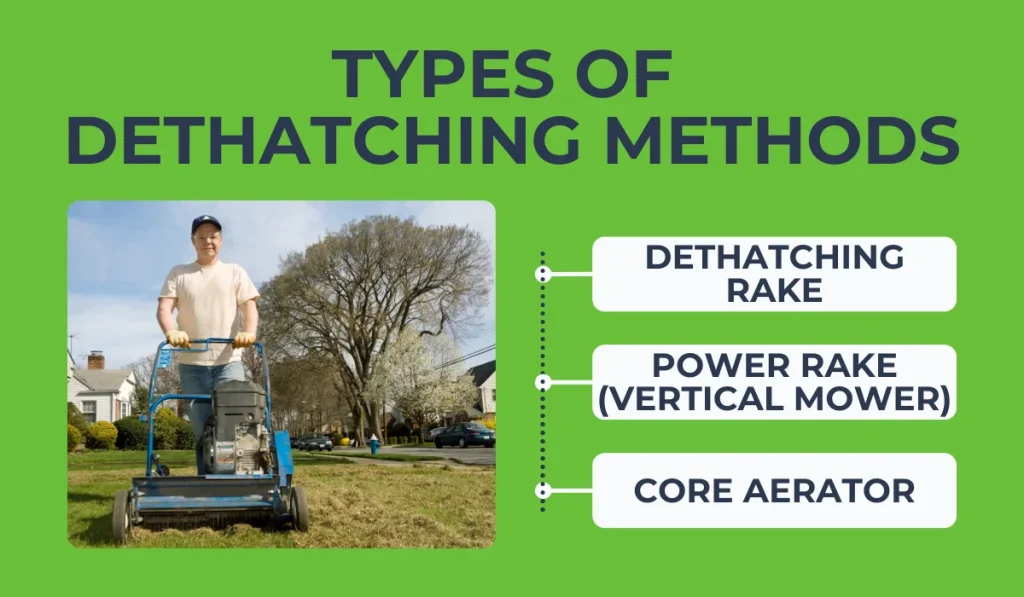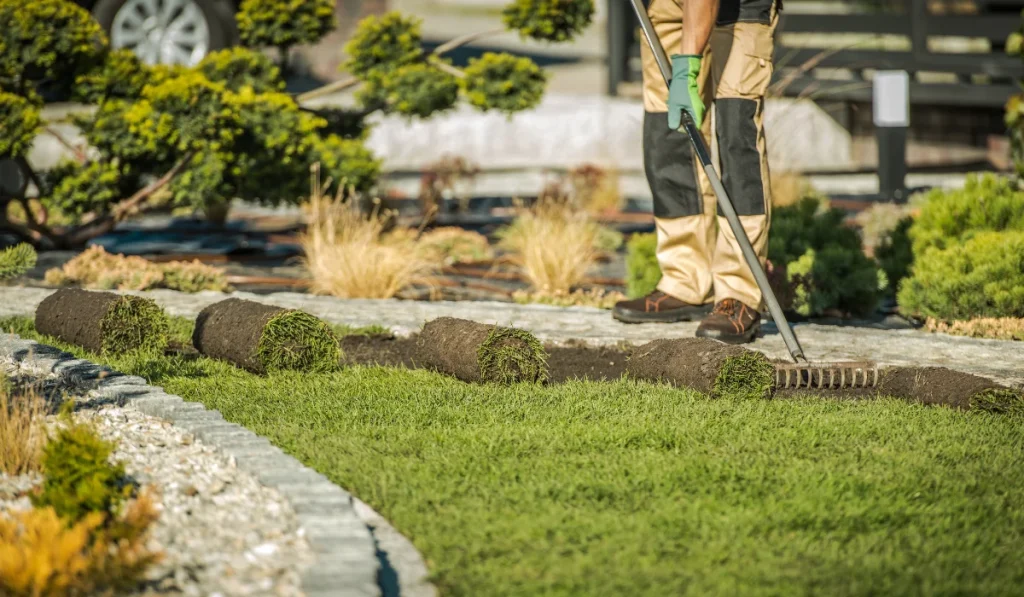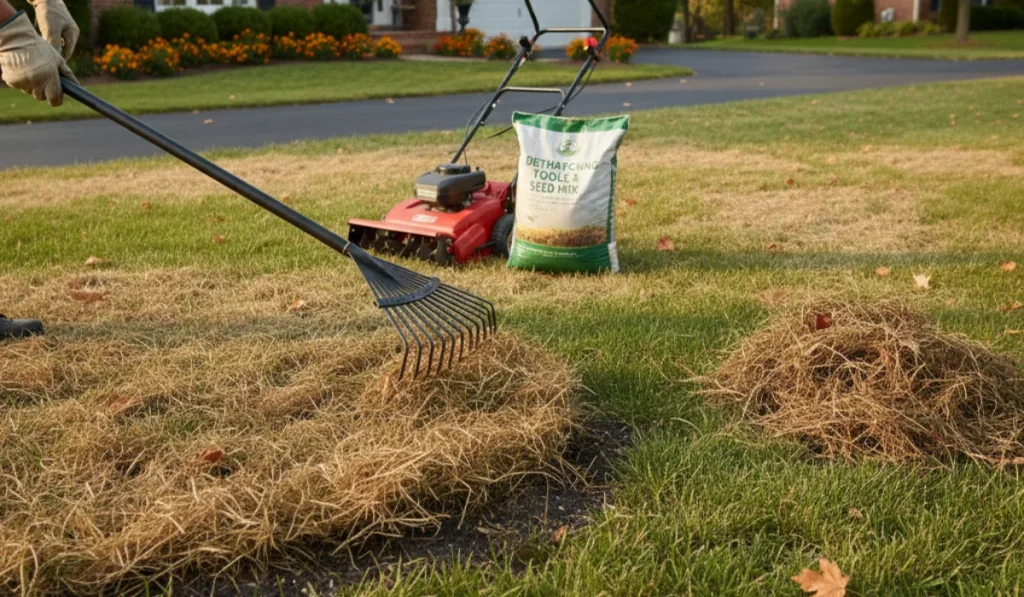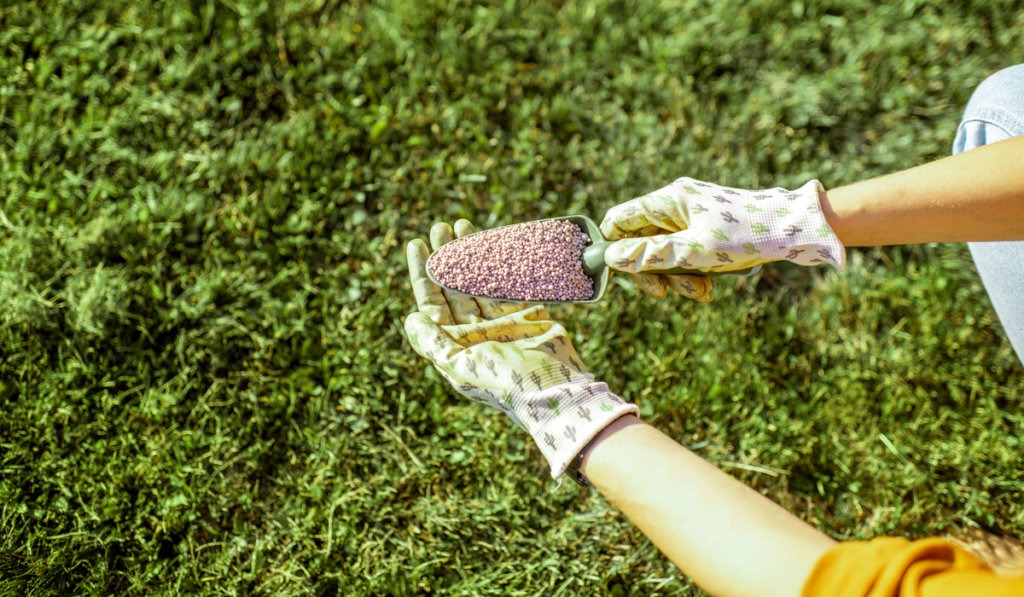Achieving a healthy, vibrant lawn requires more than just regular mowing and watering. Dethatching, the process of removing excessive organic material from your lawn, is a crucial step in lawn maintenance. But how often should you dethatch your lawn?
The answer depends on the type of grass, soil conditions, and signs of thatch buildup.
Key Takeaways
- Thatch blocks water and nutrients from the soil, so dethatching is important for keeping your lawn healthy.
- Cool-season grass needs dethatching every 2–3 years, while warm-season grass may need yearly dethatching for best growth.
- Clay soil causes thatch to build up faster, so lawns in clay soil need dethatching every 1–2 years.
- Good lawn care, like mowing, fertilizing, aerating, and removing dead grass, helps prevent thatch and keeps your lawn healthy.
How Often Should You Dethatch?
Dethatching involves removing the layer of thatch—a mix of dead grass, grass roots, and other organic matter—that accumulates between the soil surface and the grass blades.
While a thin layer of thatch (less than half-inch thick) is beneficial for insulation, too much thatch can create issues. It blocks water, air, and nutrients from reaching the soil, leading to poor grass growth and even pest problems.
The frequency of dethatching depends on several factors:
1. Turfgrass Type
Some grass types are more prone to excessive thatch accumulation than others, requiring more frequent dethatching.
- Cool-Season Grasses (e.g., Kentucky bluegrass, ryegrass, and tall fescue): These grasses often need dethatching every 2–3 years. Perform this task in early fall to give the lawn time to recover before winter.
- Warm-Season Grasses (e.g., bermudagrass, zoysia, and St. Augustine): These grasses may require annual dethatching, best done in early spring or late spring, when they are actively growing.
2. Thatch Buildup
Using a dethatching rake or a trowel, measure the thatch layer in your lawn. If it’s more than ½ inch thick, it’s time to dethatch. A thick thatch layer can suffocate your lawn and lead to disease.
3. Soil Type
Clay soil retains water poorly, which can lead to faster thatch buildup.
This type of soil often requires more frequent dethatching, typically every 1–2 years, to prevent a thick layer from forming and hindering your lawn’s health.
Types of Dethatching Methods

When it’s time to tackle a thatch problem, you can choose from several methods:
Dethatching Rake
A dethatching rake is ideal for small lawns or light thatch buildup.
Its sharp tines manually break up and remove thatch, giving you precise control. It’s a simple, affordable solution for minor maintenance or spot treatments.
Power Rake (Vertical Mower)
A power rake, or vertical lawn mower, is excellent for large lawns with thicker thatch.
Its rotating blades quickly cut and remove excessive thatch. This powerful tool is best used during active growing seasons for quick lawn recovery.
Core Aerator
A core aerator is great for reducing compaction and promoting healthy grass growth.
It removes soil plugs, improving air and water flow while helping break down thatch naturally. It’s an effective addition to long-term lawn care routines.
Timing for Dethatching Your Lawn
Dethatching at the right time ensures a quick recovery for your lawn. Here’s when to do it:
| Seasons | Description |
|---|---|
| Early Spring | Perfect for warm-season grasses like bermudagrass and zoysia. |
| Late Spring to Early Summer | Some warm-season varieties, such as St. Augustine, may benefit from dethatching in these periods. |
| Early Fall | Recommended for cool-season grasses to strengthen the root system before winter. |
Signs Your Lawn Needs Dethatching
If your lawn isn’t looking its best, here are a few signs that it might be time to break out the dethatching rake:
- Water pools on the lawn surface instead of being absorbed.
- Grass blades appear thin, and your lawn looks patchy or discolored.
- You notice difficulty when trying to insert a trowel or rake into the soil.
- An inch-thick or spongy layer of thatch is present.
Preventing Thatch Buildup
To have a healthy lawn, a few simple practices can reduce the need for frequent dethatching:
- Overseed thin areas to encourage new grass growth.
- Apply a balanced fertilizer to replenish nutrients.
- Water consistently with sprinklers so the soil stays moist but not soggy.
- Remove any remaining dead grass, plant material, or grass clippings to prevent new thatch buildup.
- Avoid over-fertilizing as excess nitrogen promotes rapid grass growth, contributing to thatch accumulation.
- Regularly mow at the proper height to prevent scalping the lawn.
- Leave finely mulched grass clippings on the lawn to act as a natural mulch, which decomposes more easily than larger debris.
- Aerate annually to improve soil conditions and prevent compaction, especially in clay soil.
Keep Your Lawn Healthy with Proper Dethatching
Dethatching is a vital step in maintaining a healthy, thriving lawn. While dethatching isn’t necessary every year, understanding when and how to do it will keep your yard looking its best.
For California homeowners looking to enhance their lawn care routine, SodLawn offers high-quality sod and grass seed.
Contact us today to learn more and find everything you need to care for your lawn.
Frequently Asked Questions
Can dethatching harm my lawn if done too much?
Yes, dethatching too often can damage your lawn by removing too much thatch and stressing the grass. Overdoing it weakens the roots and slows lawn recovery, so always follow proper timing guidelines.
What’s the best tool for small lawns with light thatch?
A dethatching rake is the best choice for small lawns with light thatch. It provides control, is easy to use, and removes just enough thatch without harming healthy grass, making it highly effective.
How long does a lawn take to recover after dethatching?
Lawn recovery usually takes three to four weeks. Recovery is faster with proper care, like regular watering, balanced fertilizing, and avoiding foot traffic or heavy use during this period.



